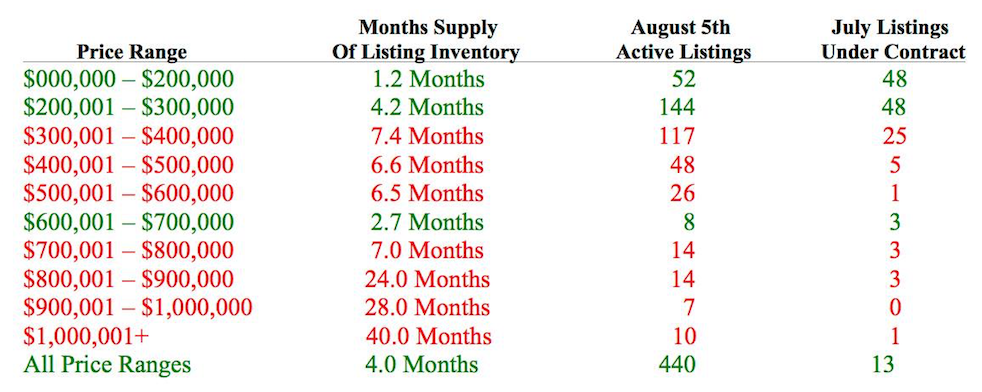Every conversation I have with Investing Architect clients or prospective clients these days eventually veers into the impact the oil market crash has had on the real estate market in general and investment opportunities in particular. With all the dramatic media coverage on the topic their expectation is one of a Buyer’s market with increased opportunities both in terms of options (inventory) and better deals (lower prices).

When you look at the aggregate numbers (all price segments lumped into one figure) the market has handled the effects of the crash surprisingly well. For instance, in the last six months aggregate year over year property sales were flat in June, up 7% in May, down 2% in April, down 1% in March, flat in February and flat in January. Same story with the year over year average sales price that were flat in June, flat in May, down 1% in April, down 1.6% in March, flat in February and flat in January.
Home inventories are up double digits from last year year’s drought but still averaged 3.5 months – well into Seller’s market territory. Not exactly something to write home about which I guess is a good sign on the back of 50%+ price drop oil crash.
A Tale of Two Cities
But, the reality on the ground is much more nuanced than those numbers suggest. It reminds me of Dickens’ book “A Tale of Two Cities”: It was the best of times, it was the worst of times. When you look at the data through the prism of price segmentation you get a very different and much more accurate view of what’s going in the real estate market. Take a look at the price segmentation schedule for a zip code in North Houston (Spring) prepared by my friend Ken Brand:

The price segments $0 to $300k reflects a Seller’s Market with improved selection through higher inventory in the upper limit. The price segments between 300k-600k is pretty much a balanced market entering a Buyer’s market. Finally, the price segment of $700k to $1MM+ is a strong unabashed Seller’s market.
From my experience on the ground, the numbers for this zip code are representative of what’s happening across the city. Generally speaking, it’s a Sellers market for price points up to $500k and a Buyer’s market for price points above $500k.
Price reductions on every other listing
If you dig below the surface, even in the price segments under $500k that are doing better many of the listings have been reduced in price. In a recent report covering The Woodlands area “48% of listings on the market have been reduced at least once” (cit Ken Brand). What’s happening in the Woodlands is typical of the Greater Houston area as a whole.
So how are prices being reduced at least once but average prices remain flat?
One characteristic that all hot Sellers markets share is Sellers getting away with unreasonable prices because of a buying frenzy. If one neighbor gets away with a higher price then others will follow suit even as the market shifts and balances itself. The original price when the reduction was made was often unreasonable and reflective of a hot Seller’s market that for all intents and purposes is no longer with us. The price reductions you are seeing are those Sellers coming back down to earth. Having said that, price reductions have a strong psychological effect on Sellers that leads to more leverage for Buyers in negotiations where they had none in the last few years.
Investment Opportunities
What does this mean for investors who are trying to dip their toe back into the market or get started for the first time? Well if you segment the market even further and look at the price point between $140-$200k where most investment opportunities will be found you will find an even stronger Seller’s market. Especially in the lower end of that range, it appears that the market keeps chugging along like it’s 2014: Days on market in the single digits, sometimes multiple offers, a bit more flexibility on price (but not much). We are still finding opportunities but the competition is fierce.
The rental market
On the rental side the situation is a lot brighter. In the last six months of the year, leases were up an average of 8% while rents were up and average of 1.55% year over year.
But, this tale of two cities analogy applies to the leasing market as well. Luxury rentals ($2000+/mo) have born the brunt of the impact while listings priced around the average have continued to perform well. Layoffs in oil and gas and dramatically reduced exploration budgets have meant that fewer people are moving into the area so the Tenant demand while solid, is now more balanced against supply. There has been a slight uptick in days on market and we are seeing an increase in Tenant requests for price reductions.
We’re having the same conversations, Erion. Just a few more numbers to add to your post, which, by the way, is the most succinct on the subject I’ve seen this year.
During this oil price crash in what’s clearly an oil state, we’ve seen the following three indicators change:
1. Rents have risen. This is despite the head winds of constant new starts for residential income property all over the state.
2. Prices for 1-4 unit rental properties have gone up significantly, and better yet, consistently.
3. The vacancy factor has either remained at 5%, or in many spots dropped to 4%.
These things simply can’t happen without incessant demand from all pertinent quarters.
Excellent points, Jeff. Thanks for your comment.
Class A small multifamily properties slot in nicely in between Class A single family homes (that are getting too expensive as prices rise) and large Class A multifamily properties (lots of new developments across Texas) that charge high rents but can’t compete with features like 2 car garages and fenced in backyards. With low vacancy rates in the single digits, many of our investor clients whose prior focus was single family properties are now switching to small multifamily properties.
One additional benefit to these small multifamily projects is location diversification. While Texas is usually considered an “oil” state, submarkets within it have different characteristics. For instance, Houston is the center of gravity for oil and oil related business plus a large import export player due to the Port. Austin is driven by the largest state school (UT) and tech companies that have opened up campuses in droves. San Antonio is more military and manufacturing (i.e Toyota Plant). Dallas Fort Worth, more corporate headquarters. So by purchasing small MF projects across these different markets you achieve diversification within the state.